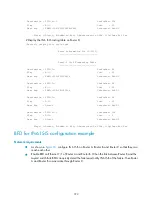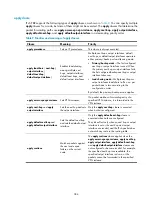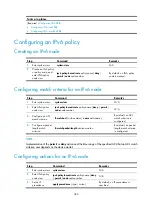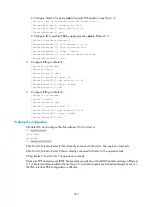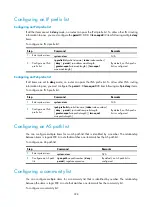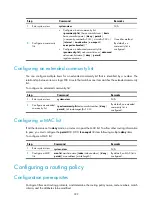
392
# Configure Node 5 for policy
aaa
to forward TCP packets to next hop 1::2.
[RouterA] ipv6 policy-based-route aaa permit node 5
[RouterA-pbr6-aaa-5] if-match acl 3001
[RouterA-pbr6-aaa-5] apply next-hop 1::2
[RouterA-pbr6-aaa-5] quit
# Configure IPv6 interface PBR by applying policy
aaa
to Ethernet 1/1.
[RouterA] interface ethernet 1/1
[RouterA-Ethernet1/1] ipv6 address 10::2 64
[RouterA-Ethernet1/1] undo ipv6 nd ra halt
[RouterA-Ethernet1/1] ripng 1 enable
[RouterA-Ethernet1/1] ipv6 policy-based-route aaa
[RouterA-Ethernet1/1] quit
2.
Configure RIPng on Router B.
<RouterB> system-view
[RouterB] ripng 1
[RouterB-ripng-1] quit
[RouterB] interface serial 2/0
[RouterB-Serial2/0] ipv6 address 1::2 64
[RouterB-Serial2/0] ripng 1 enable
[RouterB-Serial2/0] quit
3.
Configure RIPng on Router C.
<RouterC> system-view
[RouterC] ripng 1
[RouterC-ripng-1] quit
[RouterC] interface serial 2/1
[RouterC-Serial2/1] ipv6 address 2::2 64
[RouterC-Serial2/1] ripng 1 enable
[RouterC-Serial2/1] quit
Verifying the configuration
# Enable IPv6 and configure the IPv6 address 10::3 for Host A.
C:\>ipv6 install
Installing...
Succeeded.
C:\>ipv6 adu 4/10::3
# On Host A, Telnet to Router B that is directly connected to Router A. The operation succeeds.
# On Host A, Telnet to Router C that is directly connected to Router A. The operation fails.
# Ping Router C from Host A. The operation succeeds.
Telnet uses TCP, and ping uses ICMP. The preceding results show that all TCP packets arriving on Ethernet
1/1 of Router A are forwarded to the next hop 1::2, and other packets are forwarded through Serial 2/1.
The IPv6 interface PBR configuration is effective.


